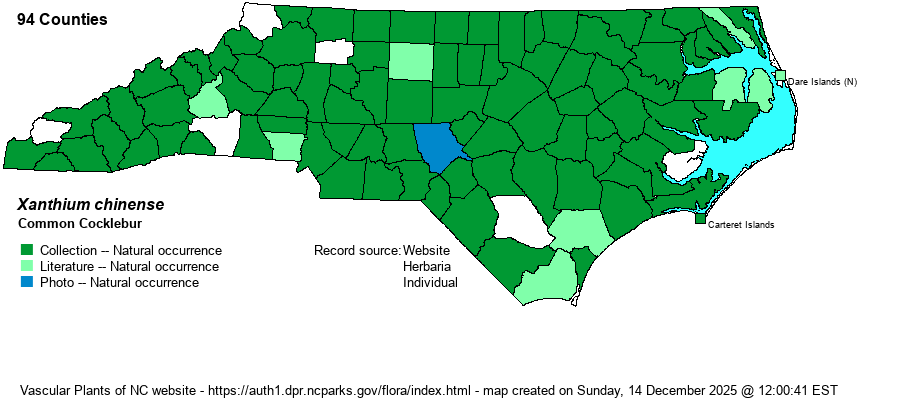| Author | P. Miller | |
| Distribution | Throughout the state; doubtless in every county.
Widespread in eastern North America. The original distribution is uncertain, but generally believed to be native to the eastern U.S., and not just in eastern Asia. | |
| Abundance | Common to often locally abundant statewide -- especially in the Coastal Plain. | |
| Habitat | Originally, moist to mesic soils of seasonally inundated floodplains and bottomlands, often in backup channels, oxbow ponds, and natural depressions in floodplains. Since human settlement, now mostly found in barnyards, pastures, fallow fields, clearings, and other disturbed soil. Often common on drawdown shorelines of rivers in summer and fall -- a surprising habitat. | |
| Phenology | Flowering and fruiting August-October. | |
| Identification | Common Cocklebur is readily identified by its 1-2 cm long, elliptical, tan or light brown fruits that are beset with straight and hooked prickles -- that easily stick to clothing. Plants usually sprawl on other vegetation, and stem and branches may grow as much as 6 feet, but usually half that or less. The leaves are large and triangular to palmately-lobed, like a small grape (Vitis) leaf. Flowers are insignificant, and thus many people have no idea that cocklebur species are actually composites, in the aster family. Oriental Cocklebur (X. orientale) is very similar, but differs in its darker brown fruits beset with short, glandular hairs; it also is considered as a native species to our area, despite its name. | |
| Taxonomic Comments | See revised nomenclature in Weakley (2018). Most references name the native species as X. strumarium.
| |
| Other Common Name(s) | Cocklebur | |
| State Rank | S5 | |
| Global Rank | G5T5? [G5?] | |
| State Status | | |
| US Status | | |
| USACE-agcp | | |
| USACE-emp | | |

